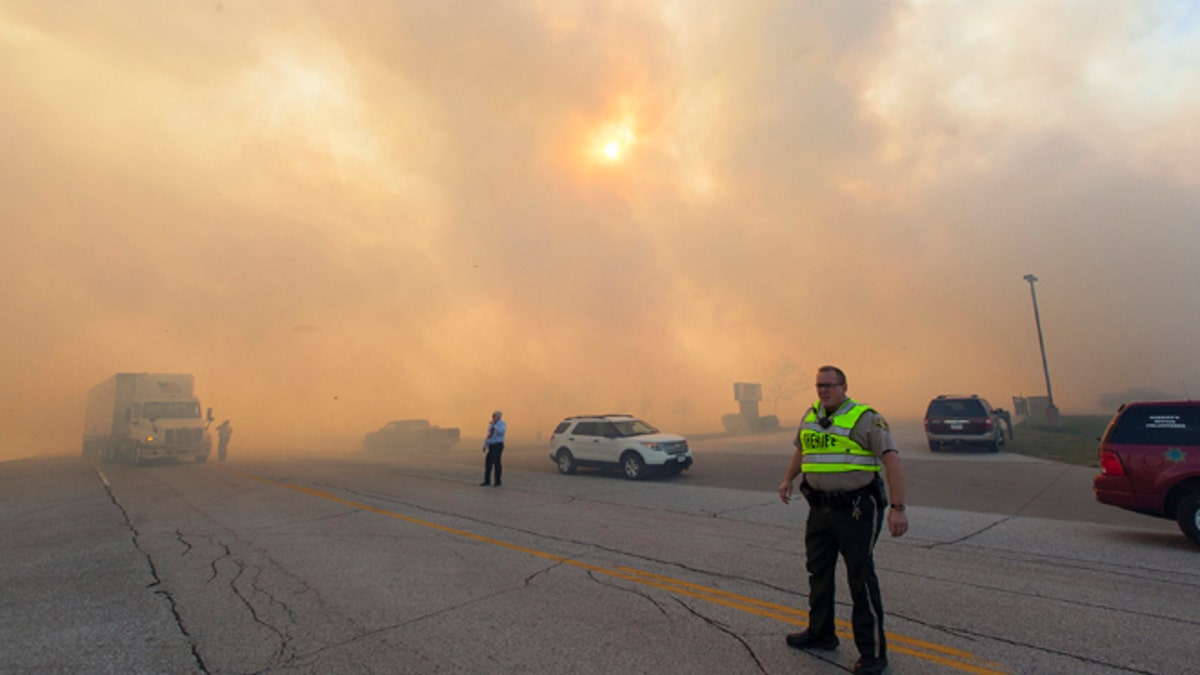
Oct. 12, 2015: Authorities direct traffic for vehicles passing through heavy smoke from a burning field in Eldridge, Iowa. (Louis Brems/Quad City Times via AP, File)
CHEYENNE, Wyo. – Wildfires burning on prairie land in five states have destroyed more than a dozen homes and killed livestock in the past few days as a region normally accustomed to crisp temperatures and even snow this time of year gets a taste of California-style drought.
Fires with volcano-like smoke plumes visible for miles around have broken out from the Rockies almost to the Mississippi River.
Ample rain during the spring and summer made matters worse by encouraging prairie grass to grow into deep, thick wildfire fuel.
"All they needed was a spark," said Kelly Allen, a National Weather Service fire program manager in Riverton, Wyoming. "Now they're finally burning. The fuel bed is almost continuous."
In Wyoming, winds drove a landfill fire across almost 16 square miles of prairie and burned 13 homes. Nobody was hurt but pets and livestock perished, left behind as some 1,300 people rushed to evacuate the rural area.
"It's a nightmare," said Daniel Clark. "I don't even know how to feel."
Clark lost his home, barn, six dogs, five cats, two horses, a cow and his wife's wedding ring. He was able to rescue two dogs and a horse before smoke forced him out of the area, he told the Casper Star-Tribune.
A neighbor shot one of his horses, mercifully, after it ran from the barn in flames.
Calmer winds helped firefighters begin to get a handle on the flames. They prepared to allow evacuees to return Tuesday evening.
"We're anticipating a lot of cars. It will be interesting. These people will be wanting to get back home, for sure," Natrona County Fire Marshall Bob Fawcett said.
The fire began at a composting area of the Casper Regional Landfill on Saturday and continued to menace an ever-wider expanse of prairie Tuesday. Afternoon winds that kept driving the flames beyond firefighters' reach were forecast to continue.
The Red Cross asked Casper residents to donate yard implements — shovels, rakes, leather gloves — to aid the task of sifting through debris for any personal belongings.
A blizzard wouldn't be unusual anywhere in Wyoming this time of year but this fall has been more like July, with recent highs in the low 80s.
"We haven't had much moisture across the state since, really, the beginning of September. Just these hot, dry days — fairly high temperatures and low relative humidity," Wyoming State Forester Bill Crapser said Tuesday.
Elsewhere over the past few days:
-- A fire burned about 4.5 square miles of the Standing Rock Indian Reservation in northern South Dakota.
--On the North Dakota side of the same reservation, gusts up to 60 mph blew a fire into the community of Cannon Ball, destroying three homes and a church. About 875 residents had to evacuate from the blaze that scorched nearly 8 square miles.
--Grass fires elsewhere in the Dakotas destroyed at least one home and shut down highways including part of Interstate 29.
--In eastern Iowa, farm field blazes scorched more than three square miles of Scott County. Two firefighters underwent treatment for smoke inhalation.
--A fire burned 13 square miles of grassland and threatened about 50 homes and ranches near the southern Montana town of Manhattan.
--A hot wildfire season in western Idaho continued as a 5-square-mile forest fire burned three cabins 40 miles northeast of Boise.
The National Weather Service posted wildfire warnings Tuesday for central and southern Wyoming and a swath of east-central Nebraska. Warm, dry weather will continue through the weekend with rain likely no sooner than next Tuesday, Allen said.
Overnight Monday, cool temperatures helped firefighters in the Casper area regain ground lost to a wind-driven flare-up the previous afternoon. They used bulldozers to scrape a line of defense in the ground ahead of the fire's northern flank and by Tuesday afternoon got the fire 50 percent contained.

